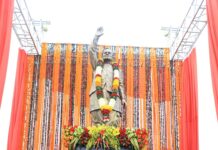By Our Correspondent
NEW DELHI/BHUBANESWAR/ANGUL: With Three States including Maharashtra ruled by Shiv Sena , Chhattisgarh by Congress and Jharkhand’s JMM have already opposed Commercial Coal Mining in their States since Prime Minister Narendra Modi announced auction of 41 Blocks on June 18, the National Alliance of People’s Movements (NAPM), has asked the Government to immediately revoke the auction of 41 coal blocks for commercial mining in order to “stop corporate loot in eco-sensitive and Schedule V Adivasi areas of Central and Eastern India”. Out of the total 41, 9 Coal Mines Blocks put for Auction in Odisha.
Of the 9 auctioned coal blocks in Odisha, 8 are in Angul district; spread over 30,000 hectares, where people’s resistance against destructive mining has been ongoing for years. Talcher-Angul and IB Valley were declared as ‘Critically Polluted Areas’ by the Central Pollution Control Board (CPCB), for three decades now with little ‘improvement’, rather deterioration in the environment, people’s health and more displacement.
These coal blocks are located in densely populated areas, with thousands of families and in the proximity of important rivers like Brahmani. Commercial coal mining would lead to further ecological degradation, displacement and a complete decimation of the water streams and canals in the area.Despite opposition from conservationists and objections from the State Forest Dept in Maharashtra, Bander which is an 80 % forest zone and an eco-sensitive tiger corridor, even as per studies by agencies of Coal India Limited, has been auctioned for the coal block.
The mines are Chendipada I, Chendipada II, Machhakata, Mahanadi, Radhikapur (East), Radhikapur (West), Brahmanbil & Kardabahal, Kuraloi (A) North, and Phuljhari (East & West). Private players like Rungta Mines Limited, Jindal Steel and Power Ltd, JSW Steel-Energy, Essel Mining and Industries Ltd, Hindalco, Tatas, Sesa Goa, Vedanta Industries Ltd, Adani Group, Thriveni Earth Movers Pvt Ltd and global players like Rio Tinto, BHP Billiton, PesBody, Glencore and Vale are among those eyeing on Odisha’s Coal blocks.
Most of these Blocks belongs Angul-Talcher coal Belt, close to Satkosia and Similipal Tiger Reserves. Satkosia spreads along the magnificent gorge over the mighty river Mahanadi in Odisha. Established in 1976 as a wildlife sanctuary, Satkosia is a paradise of immense scenic charm. It is one of the best ecosystems in the country, representing a diverse floral and faunal extravaganza. The Reserve is spread over 4 districts like; Angul, Cuttack, Nayagarh and Boudh. The reserve has an area of 963.87sq km with 523.61sq km as core area. The area is also a part of the Mahanadi elephant reserve. Satkosia is the meeting point of two bio-geographic regions of India; the Deccan Peninsula and the Eastern Ghats, contributing immense biodiversity.
Importantly, the National Tiger Conservation Authority has identified a potential link for the migration of wild animals from the Similipal Tiger Reserve to the Satkosia Tiger Reserve and has proposed a corridor. It is a very long corridor, but is highly fragmented due to intense mining activities, power stations and a large number of human habitations. According to a study by the Wildlife Institute of India, Dehradun, conducted in 2014, there are more than 250 villages in and around of this corridor.
A part of this proposed corridor connects the Similipal National Park with the Hadgarh Wild-life Sanctuary through the Noto and Satkosia Reserve Forests. The other corridor considered to be important for the movement of the animals is the BaulaKuldiha corridor, which is 15-16 km long. This corridor connects the Kuldiha Wild-life Sanctuary with the Hadgarh Wildlife Sanctuary through small hillocks in the Garsahi Reserve Forest, Gaguapahar, Balihudi and Baula hills. This corridor is being used by herds of 20-25 elephants. The Hadgarh-Kuldiha corridor is also being used by small herds of 10-15 elephants.
The laws including the Scheduled Tribes and Other Traditional Forest Dwellers (Recognition of Forest Rights) Act, 2006 (in short, FRA),the Provisions of the Panchayats (Extension to the Scheduled Areas) Act, 1996 (PESA) ,the Environment Protection Act, 1986 and EIA Notification, 2006, right to Fair Compensation and Transparency in, Land Acquisition, Rehabilitation and Resettlement Act, 2013 (LARR Act) violated.
The unilateral decision to auction is also violative of multiple judgements of the Supreme Court including:Judgement dt July 11, 1997 in Samata vs State of Andhra Pradesh and Ors which held that all entities including the State are ‘non-adivasis’ and adivasi co-operatives alone have the right to undertake mining in their land, if they so wish.Judgement dt April 18, 2013 in Odisha Mining Corporation Ltd vs Ministry of Environment & Forest (Niyamgiri Judgement) wherein a three-judge Bench upheld the constitutional right of the Gram Sabhas to consider and decide as to whether mining in their areas can be undertaken or not.
Judgement dt July 8, 2013 in Thressiamma Jacob & Ors vs Geologist, Dept. of Mining, wherein a three-judge Bench headed by Justice R.M. Lodha held that ownership of minerals should be vested with the land owners. Judgement dt August 25, 2014 in Manohar Lal Sharma vs The Principle Secretary & Others (Coalgate Case), wherein a three-judge Bench headed by the Chief Justice clearly held that coal is “national wealth” which should only be used for ‘common good’ and ‘public interest’.
Commercial Mining in the absence of the prior consent of and consultation with the Gram Sabhas, the primary decision-making body of a village in Scheduled Areas, is a clear constitutional and statutory violation. Further, the Forest Rights Act clearly defines forest as a community resource of the Gram Sabha.It is, therefore, no surprise that the declaration of 41 coal blocks being opened up for commercial mining, with 9 coal blocks each in Jharkhand, Chhattisgarh and Odisha, 11 in Madhya Pradesh and 3 in Maharashtra, as part of the 11th tranche of coal block auctions has evoked sharp reactions from many Gram Sabhas, people’s organizations and trade unions in the five states, along with three state governments.
National Alliance of People’s Movements (NAPM) condemns the diabolical design of the current regime, led by the Prime Minister to ‘virtually auction’ 41 coal blocks for commercial mining in the bio-diverse rich, adivasi heartlands of Central and Eastern India. Opening up of these areas to profit-making domestic and foreign corporate mining entities will irreversibly jeopardize the pristine forest lands, increase environmental pollution and public health risk in Covid times and destroy the habitats of a major chunk of the adivasi population and wild-life, it said.
This move is yet another hoax by the Prime Minister on the people of this nation couched in the deceitful jargon of “Atma Nirbhar Bharat” and infact takes away the constitutional rights of self-governance. Using Covid as a pretext for ‘economic revival’, the government is resorting to a severe transgression of the rights of the communities dependent on land and forests in these areas. After 47 years of public sector ownership by Coal India Limited, the sector is now being handed over to private players to exploit the fragile ‘no-go’ regions and rich resources.
It may be noted that the auctioning announcement was made pursuant to the recent Mineral Laws (Amendment) Act, 2020, passed in March, 2020 [promulgated as an ordinance in January], to amend the Coal Mines (Special Provisions) Act, 2015 and the Mines and Minerals (Development and Regulation) Act, 1957, in order to ‘ease restrictions’ on end use and relax the eligibility criteria for participating in coal auctions, especially enabling FDI by global bidders. Infact, in Aug 2019, the Modi approved 100% FDI via the ‘automatic route’ for coal mining, processing and sale.
The decision has been vociferously opposed by the Chhattisgarh Bachao Andolan. About 20 Gram Sabhas from Hasdeo Arand region in Chhattisgarh who have been resisting the coal mining since 2015 have written to the Prime Minister to stop the auctioning. Hasdeo Arand, is the longest forest stretch in Central India spread over 1,70,000 hectares, a valuable elephant corridor and home to the Gond adivasis.
The State Forest Minister has written to the Union Environment Minister to exclude Hasdeo Arand, Mand river coal blocks and Lemru Elephant Reserve (1,995 sq km of forest area) located in the catchment area from the auction, in order to prevent loss of human lives and human-elephant conflict. The area already has four operational mines, five allotted mines and 12 coal reserves.
Organizations in Jharkhand including coalitions like Jharkhand Janadhikar Mahasabha have given mass protest calls against the decision of Centre. The Jharkhand government after ‘conditionally welcoming’ the commercial mining and seeking a moratorium period of 6-9 months on the auction process to ensure ‘an equitable sustainable mineral-based development, has now approached the Supreme Court citing ‘need for fair assessment of social and environmental impact on the huge tribal population and vast tracts of forest lands which are likely to be adversely affected’.The petition in SC also states that the Mineral Laws Amendment Act, 2020 passed on 13th March 2020, with a 60 days applicability period lapsed on 14th May and thus the auction cannot take place amidst ‘legal vacuum’.






























